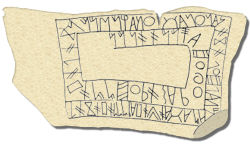Southwest Paleohispanic script



The Southwest Script or Southwestern Script, also known as Tartessian or South Lusitanian, is a Paleohispanic script used to write an unknown language usually identified as Tartessian. Southwest inscriptions have been found mainly in the southwestern quadrant of the Iberian Peninsula, in the south of Portugal (Algarve and southern Alentejo), but also in Spain, in southern Extremadura and western Andalucia.
Contents
Name of the script
The name of this script is very controversial. The more neutral name is southwestern, because it refers only to the geographical location where the inscriptions had been found, but it needs some additional precision in a general context. Some researchers name this script Tartessian considering it the script of Tartessos. Others prefer to name this script as South Lusitanian, because almost all the southwestern inscriptions have been found in the south of Portugal (an area included in the Roman province of Lusitania), where the Greek and Roman sources locate the Pre-Roman Conii or Cynetes people, instead in the zone generally considered Tartessian (between Huelva and the Guadalquivir valley). But on the other hand, the name South Lusitanian is inconvenient, as it may wrongly suggest a relation with the Lusitanian language. Other name proposals include Bastulo-Turdetanian and escrita cónia.
Writing system
Excepting the Greco-Iberian alphabet, and to a lesser extent this script, paleoiberian scripts shared a distinctive typology: They behaved as a syllabary for the stop consonants and as an alphabet for the remaining consonants and vowels. This unique writing system has been called a semi-syllabary. There is no agreement about how the paleohispanic semi-syllabaries originated; some researchers conclude that their origin is linked only to the Phoenician alphabet, while others believe the Greek alphabet had also participated. In the southwestern script, although the letter used to write a stop consonant was determined by the following vowel, as in a full semi-syllabary, the following vowel was also written, as in an alphabet. A similar convention is found in Etruscan for /k/, which was written KA CE CI QU depending on the following vowel. Some scholars treat Tartessian as a redundant semi-syllabary, others treat it as a redundant alphabet.
The southwestern script is very similar to the southeastern Iberian script, both considering the shape of the signs or his value. The main difference is that southeastern Iberian script doesn’t show the vocalic redundancy of the syllabic signs. This characteristic was discovered by Ulrich Schmoll and allows the classification of a great part of the southwestern signs in vowels, consonants and syllabic signs. Unlike the northeastern Iberian script the decipherment of the southeastern Iberian script and the southwestern script is not still closed, because there are a significant group of signs without consensus value.
Inscriptions
This script is almost exclusively used in near a hundred large stones (steles), probably with funerary purpose. Almost always the direction of the writing is right to left, but also boustrophedon or spiral. The fact that almost all the southwestern inscriptions had been found out of archaeological context does not permit fixing a precise chronology, but it seems clear that it was used in the 5th century BC; however it is usual to date them from the 7th century BC and consider that the southwestern script is the most ancient paleohispanic script.
A total of 75 southwest script stelae are known. Of these, 16 can be seen in the Southwest Script Museum[1] (Museu da Escrita do Sudoeste, in Portuguese), in Almodôvar (Portugal), where a recently[when?] discovered stele with a total of 86 characters (the longest inscription found so far) will also be[when?] on display.[2][3][4]
See also
- Espanca script
- Pre-Roman peoples of the Iberian Peninsula
- Prehistoric Iberia
- Timeline of Portuguese history
- Cempsi and Saefs
- Celtici
References
- ↑ Southwest Script Museum - official site
- ↑ Dias, Carlos (2008), "Descoberta perto de Almodôvar a mais extensa inscrição em escrita do sudoeste", in Público, Ano XIX, n.º 6742 - 15/09/2008, p.18.
- ↑ Lua error in package.lua at line 80: module 'strict' not found.
- ↑ Lua error in package.lua at line 80: module 'strict' not found.
- Correa, José Antonio (1996): «La epigrafía del sudoeste: estado de la cuestión», La Hispania prerromana, pp. 65–75.
- Correia, Virgílio-Hipólito (1996): «A escrita pré-romana do Sudoeste peninsular», De Ulisses a Viriato: o primeiro milenio a.c., pp. 88–94
- Guerra, Amilcar (2002): «Novos monumentos epigrafados com escrita do Sudoeste da vertente setentrional da Serra do Caldeirao», Revista portuguesa de arqueologia 5-2, pp. 219–231.
- Hoz, Javier de (1985): «El origen de la escritura del S.O.», Actas del III coloquio sobre lenguas y culturas paleohispánicas, pp. 423–464.
- Rodríguez Ramos, Jesús (2000): «La lectura de las inscripciones sudlusitano-tartesias», Faventia 22/1, pp. 21–48.
- Schmoll, Ulrich (1961) : Die sudlusitanischen Inschriften, Wiesbaden.
- Untermann, Jürgen (1997): Monumenta Linguarum Hispanicarum. IV Die tartessischen, keltiberischen und lusitanischen Inschriften, Wiesbaden.
- Valério, Miguel (2008): Origin and development of the Paleohispanic scripts: The Orthography and Phonology of the Southwestern Alphabet[1]
